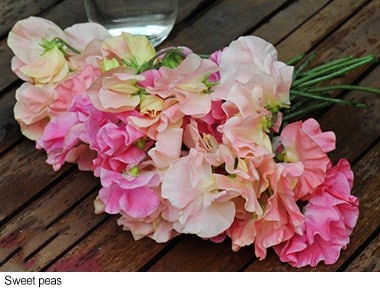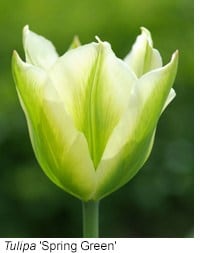At some stage in June, your garden will be a glorious affair full of scent and soft flower. Placing a posy from the garden, close to a family hub like the kitchen table, unites your home and garden as effectively as having a huge picture window. You don’t have to be a serious flower arranger either. All it takes is a simple jug, or small vase of well-chosen plants carefully harvested so that your garden hardly notices. If you have a larger garden, it’s well worth creating a designated cutting garden specially for picking perennials, bulbous plants and annuals in country house style. Your cutting garden could have wicker edges, or obelisks at each corner, or a simple picket fence should you wish. If you have a smaller garden you can still snip away, but never denude your plants because garden flowers last much longer than cut flowers.

Cut the flowers in the morning if you can, as early as possible, and immediately immerse each stem in a bucket of cool water up to its neck and then stand them in a shady place and let them drink for a few hours. This will also allow any pollen beetles to escape, a necessity for sweet peas. Soft stems need a diagonal cut with sharp scissors to increase the surface area of stem and help the uptake of water. Woody stems need distressing, with a small hammer or similar. When arranging, don’t allow any foliage to linger below the waterline, it will green up the water as it decomposes killing the flowers. It will also smell. Change the water regularly, or top it up. Refresh the flowers by taking them out of the container and discard any spent flowers. Recut the stems of those that will do a little longer. Shake each flower so that it sheds any debris and then rearrange.
Bulbous and Tuberous Flower for Cutting

Agapanthus are also slightly tender, but the ones that die away and show a deciduous tendency mainly overwinter. Start with the Headbourne hybrids, because these have been grown outside for decades. Purple alliums (which need planting in September) are also a good addition and ‘Purple Sensation’ cannot be beaten for vigour and colour. Pick as the buds open, or leave the flowerhead to turn green and then dry it. Never allow alliums to self-seed, because this diminishes the mother bulb.
 ‘Purple Sensation’ is a perfect follow up act for tulips and the following can be left in to become perennial. ‘Spring Green’ is a cool green and white, ‘Ballerina’ is a scented terracotta and ‘Negrita’ is a deep-purple. ‘Shirley’ is a purple-mottled white. However it opens pale yellow, before dappling occurs. Cut tulips will grow in the vase, so be prepared to recut the stems every two days. Also tulips need to be arranged on their own: they add a toxin to the water that diminishes other flowers. However they are worth growing and cutting as they swoon very elegantly. Tulip bulbs need to be planted in cool conditions, so wait until late October or November because this will avoid the common fungal disease Tulip fire (Botrytis tulipae). All other bulbs go in during September.
‘Purple Sensation’ is a perfect follow up act for tulips and the following can be left in to become perennial. ‘Spring Green’ is a cool green and white, ‘Ballerina’ is a scented terracotta and ‘Negrita’ is a deep-purple. ‘Shirley’ is a purple-mottled white. However it opens pale yellow, before dappling occurs. Cut tulips will grow in the vase, so be prepared to recut the stems every two days. Also tulips need to be arranged on their own: they add a toxin to the water that diminishes other flowers. However they are worth growing and cutting as they swoon very elegantly. Tulip bulbs need to be planted in cool conditions, so wait until late October or November because this will avoid the common fungal disease Tulip fire (Botrytis tulipae). All other bulbs go in during September.
 Two summer flowering bulbs can also play their part. Dahlias are a superb cut flower, but do opt for the fuller-flowered doubles such as ‘David Howard’, which last longer. Grow some dark forms too because they look very ornate in border or vase. The Karma series, deliberately bred in Holland for the cut flower market, are all excellent and the dark-red ‘Karma Choc’ has bronzed foliage as well as lovely flowers.
Two summer flowering bulbs can also play their part. Dahlias are a superb cut flower, but do opt for the fuller-flowered doubles such as ‘David Howard’, which last longer. Grow some dark forms too because they look very ornate in border or vase. The Karma series, deliberately bred in Holland for the cut flower market, are all excellent and the dark-red ‘Karma Choc’ has bronzed foliage as well as lovely flowers.
Lilies are so abundant and cheap to buy they are not worth a place in most cutting gardens. Instead enjoy a potful of scented lilies by a seat. The pink-spotted ‘Tiger Edition’ is a lovely thing to grow.
Annuals and Biennials for the Cut Flowers.

Sprinkle and sow annuals can still be sown now, although they must be kept watered. Nigella, calendula, bells of Ireland, zinnias and cosmos all make colourful cut flowers. Antirrhinums are also superb, and ‘Admiral White’ could be used to calm a colourful medley in any vase. It’s also worth sowing biennials in the next week or two and these include seeds of the deep-red wallflower ‘Blood Red’, or the russet-red ‘Fire King’.








